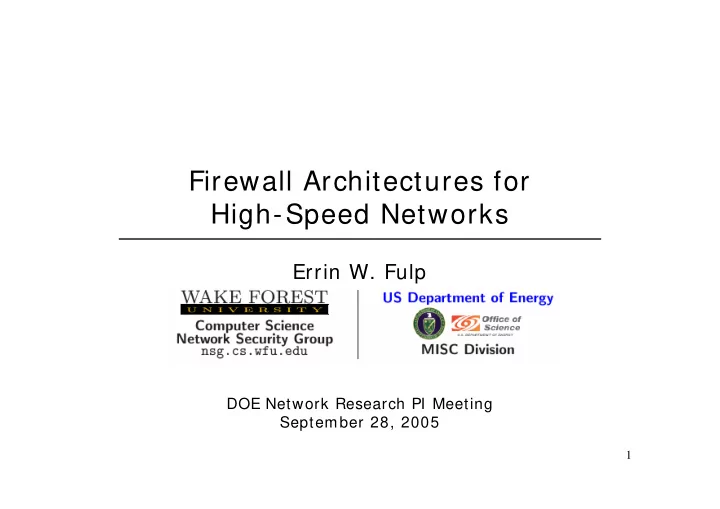

Firewall Architectures for High-Speed Networks Errin W. Fulp DOE Network Research PI Meeting September 28, 2005 1
Project Objectives Methods that improve network firewall performance 1. Develop policy optim ization techniques – Formal models for rules and security policies – Reduce processing requirement per packet – Low impact solutions for current and future firewalls – Models used to distribute rules in parallel firewalls 2. High-speed firew all designs – One policy, distributed firewalls, parallel processing – Maintain QoS requirements and differentiation – Scalable with increasing speeds and volumes – Robust (highly available), able to survive DoS attacks Wake Forest Computer Science DOE Network Research PI Meeting, 2005 E. W. Fulp 2 nsg.cs.wfu.edu
Research Progress • Three year DOE ECPI project – First year : firewall policies and analytical models – Second year : firewall designs and rule distribution – Third year : hybrid and dynamic firewall designs • Network Security Group at Wake Forest University – Errin Fulp, Ryan Farley, and Steve Tarsa Wake Forest Computer Science DOE Network Research PI Meeting, 2005 E. W. Fulp 3 nsg.cs.wfu.edu
Policy Optimization Reduce comparisons while maintaining integrity 1 . Optim ize the policy, best arrangement (NP-hard) Firewall policy Policy DAG Linear arrangement – Optimized list reduces number of compares (upto 80% ) – Rule compression and expansion 2. New non-linear representation – Policy trie requires 1/ k compares – Policy trie optimization Wake Forest Computer Science DOE Network Research PI Meeting, 2005 E. W. Fulp 4 nsg.cs.wfu.edu
Distributed Firewall Designs • Three distributed designs – Data parallel , distribute packets – Function parallel , distribute rules – Hierarchical , distribute packets and rules scalable, redundant, faster than data, scalable potentially fastest, stateful, stateful inspection difficult, stateful, redundant?, no differentiation possible, rule no differentiation differentiation distribution difficult Wake Forest Computer Science DOE Network Research PI Meeting, 2005 E. W. Fulp 5 nsg.cs.wfu.edu
Function Parallel • Each node has a portion of the policy – Every packet processed by each node, and informs gate – Gate make final decision based on the policy DAG • Results for 4-node parallel firewall – Function parallel 3 to 3.5 times better than data-parallel • Gate is an additional delay, prefer to eliminate Wake Forest Computer Science DOE Network Research PI Meeting, 2005 E. W. Fulp 6 nsg.cs.wfu.edu
Eliminating the Gate • Possible to remove the gate machine – Must distribute rules so only one node accepts – Use policy DAG and trie to guide decisions ( integrity ) • Consider a policy and two node function-parallel • Function parallel design is becoming hierarchical – Nodes are designed to handle certain types of traffic – Maintains QoS, isolate DoS attacks Wake Forest Computer Science DOE Network Research PI Meeting, 2005 E. W. Fulp 7 nsg.cs.wfu.edu
Continuing Research • Finalize proofs for rule distribution – Eliminate gate and maintaining integrity – Use policy profile to optimize performance • Create a redundant gate-less design – Use policy DAG and trie to distribute rules – Gateless performance with redundant attributes • Dynamic array of firewall nodes – Function parallel is not always better… – Use queueing theory to determine optimal design – Data and/ or function parallel distribution Wake Forest Computer Science DOE Network Research PI Meeting, 2005 E. W. Fulp 8 nsg.cs.wfu.edu
Synergistic Activities • Cyber Security Group at PNNL , Summer 2005 – Deborah Frincke, John McCoy, Tom McKenna, and Patrick Wheeler (UC Davis) – High-speed firewall and IPS designs – Developed policy optimization techniques • New Start-up Com pany , Spring 2005 – High-speed firewall and IDS/ IPS solutions – Two patents pending ( firewall optimization, rule distribution, and distributed architectures ) – Business plan developed – Initial implementation at WFU and testing at NC State – Seeking funding/ initial investors, possible SBIR Wake Forest Computer Science DOE Network Research PI Meeting, 2005 E. W. Fulp 9 nsg.cs.wfu.edu
Recommend
More recommend